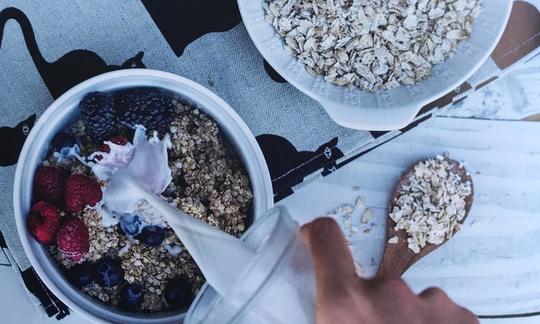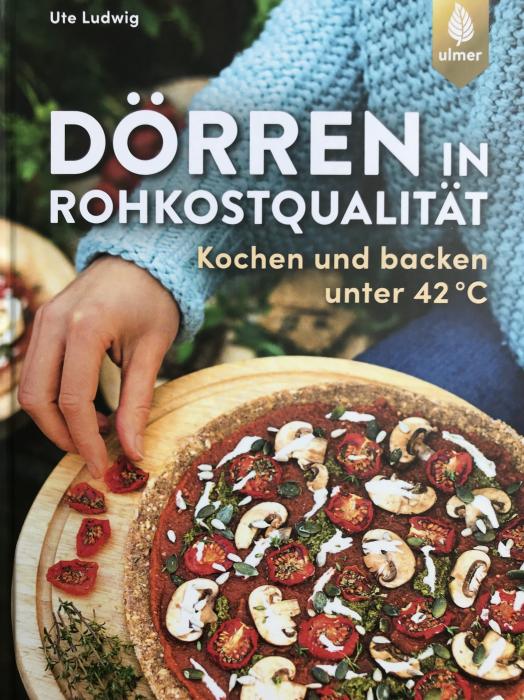Dehydrated Raw Vegan Oat and Buckwheat Crunch with Flaxseed
raw-vegan
Ingredients (for servings, )
| Soaking overnight (optional) | |
|---|---|
| 7 ⅓ oz | Buckwheat, raw (organic?) |
| Preparation | |
| 1 oz | Dates, Medjool variety, pitted, raw? (organic?) |
| 45 ml | Drinking water, raw (organic?) (1.6 oz) |
| 1 tsp | Cinnamon (ground, raw, organic?) (0.09 oz) |
| 7 ⅓ oz | Oat flakes (raw?, organic?) |
| 1 ¾ oz | Linseed, raw, organic? (golden linseed, flax) |
Equipment
- blender
- dehydrator
- sieve
Type of preparation
- dehydrate
- sprouted
- soak
- blend
- drain
Preparation
Preparation / Soaking (sprouting)
Soak the buckwheat overnight and, if desired, sprout. Then rinse and drain well. Transfer to a bowl.Instructions for sprouting can be found on page 31 of this cookbook.
Preparation
Blend the dates, water, and cinnamon in a blender to make a date paste. If needed, add additional water to achieve a paste consistency.Purchase raw rolled oats or make your own raw rolled oats from oat groats (see page 63 of this cookbook).
The original recipe for 10 servings calls for 100 g dates and 125 mL water. We have intentionally reduced these amounts (see Notes).
Add the date paste to the buckwheat and then add the rolled oats and flaxseed. Mix everything together well. If the mixture seems to dry, add a little more water.
The author uses golden flaxseed; read more about reasons for doing so under “Tips.”
Divide the mixture onto 2 dehydrator trays and spread out evenly. Dehydrate 12–15 hours at 42 °C until it is completely dry.
|
Nutritional Information per person
Convert per 100g
|
2000 kcal | |
|---|---|---|
| Energy | 180 kcal | 9.0% |
| Fat/Lipids | 4.1 g | 5.9% |
| Saturated Fats | 0.55 g | 2.8% |
| Carbohydrates (inc.dietary fiber) | 32 g | 11.8% |
| Sugars | 2.3 g | 2.5% |
| Fiber | 5.7 g | 22.9% |
| Protein/Albumin | 6.3 g | 12.5% |
| Cooking Salt (Na:3.1 mg) | 8.0 mg | 0.3% |
| Essential micronutrients with the highest proportions | per person | 2000 kcal | |
|---|---|---|---|
| Fat | Alpha-Linolenic acid; ALA; 18:3 omega-3 | 1.2 g | 59.0% |
| Min | Manganese, Mn | 1.2 mg | 58.0% |
| Min | Copper, Cu | 0.37 mg | 37.0% |
| Prot | Tryptophan (Trp, W) | 0.09 g | 36.0% |
| Elem | Phosphorus, P | 186 mg | 27.0% |
| Elem | Magnesium, Mg | 95 mg | 25.0% |
| Prot | Threonine (Thr, T, irreversibly transaminated) | 0.22 g | 23.0% |
| Prot | Isoleucine (Ile, I) | 0.25 g | 20.0% |
| Prot | Valin (Val, V) | 0.33 g | 20.0% |
| Prot | Phenylalanine (Phe, F) | 0.29 g | 19.0% |
Detailed Nutritional Information per Person for this Recipe
The majority of the nutritional information comes from the USDA (US Department of Agriculture). This means that the information for natural products is often incomplete or only given within broader categories, whereas in most cases products made from these have more complete information displayed.
If we take flaxseed, for example, the important essential amino acid ALA (omega-3) is only included in an overarching category whereas for flaxseed oil ALA is listed specifically. In time, we will be able to change this, but it will require a lot of work. An “i” appears behind ingredients that have been adjusted and an explanation appears when you hover over this symbol.
For Erb Muesli, the original calculations resulted in 48 % of the daily requirement of ALA — but with the correction, we see that the muesli actually covers >100 % of the necessary recommendation for the omega-3 fatty acid ALA. Our goal is to eventually be able to compare the nutritional value of our recipes with those that are used in conventional western lifestyles.
| Essential fatty acids | per person | 2000 kcal |
|---|---|---|
| Alpha-Linolenic acid; ALA; 18:3 omega-3 | 1.2 g | 59.0% |
| Linoleic acid; LA; 18:2 omega-6 | 0.93 g | 9.0% |
| Essential amino acids | per person | 2000 kcal |
|---|---|---|
| Tryptophan (Trp, W) | 0.09 g | 36.0% |
| Threonine (Thr, T, irreversibly transaminated) | 0.22 g | 23.0% |
| Isoleucine (Ile, I) | 0.25 g | 20.0% |
| Valin (Val, V) | 0.33 g | 20.0% |
| Phenylalanine (Phe, F) | 0.29 g | 19.0% |
| Leucine (Leu, L) | 0.43 g | 18.0% |
| Lysine (Lys, K, irreversibly transaminated) | 0.31 g | 17.0% |
| Methionine (Met, M) | 0.10 g | 10.0% |
| Vitamins | per person | 2000 kcal |
|---|---|---|
| Vitamin B1 (Thiamine) | 0.20 mg | 18.0% |
| Vitamin B7 (Biotin, ex vitamin H) | 5.8 µg | 12.0% |
| Vitamin B3 (Niacin) | 1.8 mg | 11.0% |
| Vitamin B2 (Riboflavin) | 0.13 mg | 9.0% |
| Vitamin B5 (Pantothenic acid) | 0.54 mg | 9.0% |
| Vitamin B9, B11 (Folate, as the active form of folic acid) | 17 µg | 9.0% |
| Vitamin B6 (pyridoxine) | 0.09 mg | 7.0% |
| Vitamin E, as a-TEs | 0.11 mg | 1.0% |
| Vitamin K | 0.78 µg | 1.0% |
| Vitamin C (ascorbic acid) | 0.04 mg | < 0.1% |
| Vitamin A, as RAE | 0.25 µg | < 0.1% |
| Essential macroelements (macronutrients) | per person | 2000 kcal |
|---|---|---|
| Phosphorus, P | 186 mg | 27.0% |
| Magnesium, Mg | 95 mg | 25.0% |
| Potassium, K | 227 mg | 11.0% |
| Calcium, Ca | 31 mg | 4.0% |
| Sodium, Na | 3.1 mg | < 0.1% |
| Essential trace elements (micronutrients) | per person | 2000 kcal |
|---|---|---|
| Manganese, Mn | 1.2 mg | 58.0% |
| Copper, Cu | 0.37 mg | 37.0% |
| Selenium, Se | 8.7 µg | 16.0% |
| Zinc, Zn | 1.4 mg | 14.0% |
| Iron, Fe | 1.6 mg | 12.0% |
| Fluorine, F | 3.2 µg | < 0.1% |
| Iod, I (Jod, J) | 0.36 µg | < 0.1% |
"Drying in raw food quality - Cooking and baking below 42 °C" contains many classic and health-conscious recipes as well as valuable practical tips.
Since this book is written in German, a description is omitted here. If you are interested, please switch to German in the menu.
This dehydrated raw vegan oat and buckwheat crunch with flaxseed is a delicious breakfast option. You can decide if you want to sprout the buckwheat in advance.
Ingredients: The amounts listed for the ingredients are enough for a medium-size batch, which we have listed as 10 servings.
Nutritional profile: According to GDA guidelines, a serving of this recipe meets over 50 % of the recommended daily requirement for manganese and the omega-3 fatty acid ALA. Thanks to the buckwheat, it also covers more than 30 % of the recommended daily requirement for copper and the essential amino acid tryptophan. At 1:1, the ratio of omega-6 to omega-3 fatty acids is significantly under the maximum recommended ratio of 5:1.
Rolled oats: Rolled oats contain high levels of protein and many essential amino acids. And they are also rich in vitamins and minerals—but depending on the processing (heat and steam), they may contain fewer vitamins. This recipe is only truly raw if you use raw rolled oats. Most of the rolled oats sold commercially have been heated to temperatures much higher than 42 °C in order to increase their shelf life.
Buckwheat: Buckwheat is a pseudograin. Pseudograins are seeds that aren’t in the sweetgrass family and are therefore not true grains (Poaceae). Amaranth and most other pseudograins are rich in carbohydrates, proteins, minerals, and fat, but without gluten they don’t have the same baking properties that wheat and rye do. All pseudograins are gluten-free! Buckwheat is a good source of copper, tryptophan, manganese, and magnesium.
Flaxseed: Flaxseed are the seeds of the flax plant (common flax or linseed: Linum usitatissimum). They have a slightly nutty flavor and contain 40 % fat. Since this consists of about 50 % polyunsaturated omega-3 fatty acids (ALA), flaxseed has the highest concentration of omega-3 fatty acids of all known vegetable oils. People who eat a lot of convenience foods should increase the amount of flaxseed in their diet in order to in this respect somewhat compensate for poor dietary choices.
Dates: Dates are quite sweet and are classified as a fruit. They are rich in vitamin B12 and the minerals copper and potassium. In addition, they contain more fiber than whole grain bread. In order to reduce the amount of sugar in this recipe, we have decreased the dates in this recipe by one-third. More information can be found under the following link:
A Vegan Diet Can Be Unhealthy. Nutrition Mistakes.
Storing dates: Dried dates can be stored for up to a year. If they are stored longer, then they dry out and begin to crystalize; they also become sweeter and develop a “brittle-soft” texture.
Gluten-free rolled oats: People who suffer from a gluten intolerance (celiac disease) have an immune reaction against gliadin, but they can tolerate glutenin. This means that they have to avoid traditional grains such as wheat, but that they can usually eat oats. However, it must first be verified that the oats did not come into contact with wheat or other grains containing gluten during processing and that they were cleaned in a special manner. You can purchase rolled oats that fulfill these requirements; they are labeled as gluten-free rolled oats.
Golden vs brown flaxseed: Although both varieties come from the same plant, they have a different nutritional profile and gel properties. Golden flaxseed gel better and are a better choice for flax seed gel; however, they have a poorer ratio of fatty acids (more omega-6 and less omega-3).




